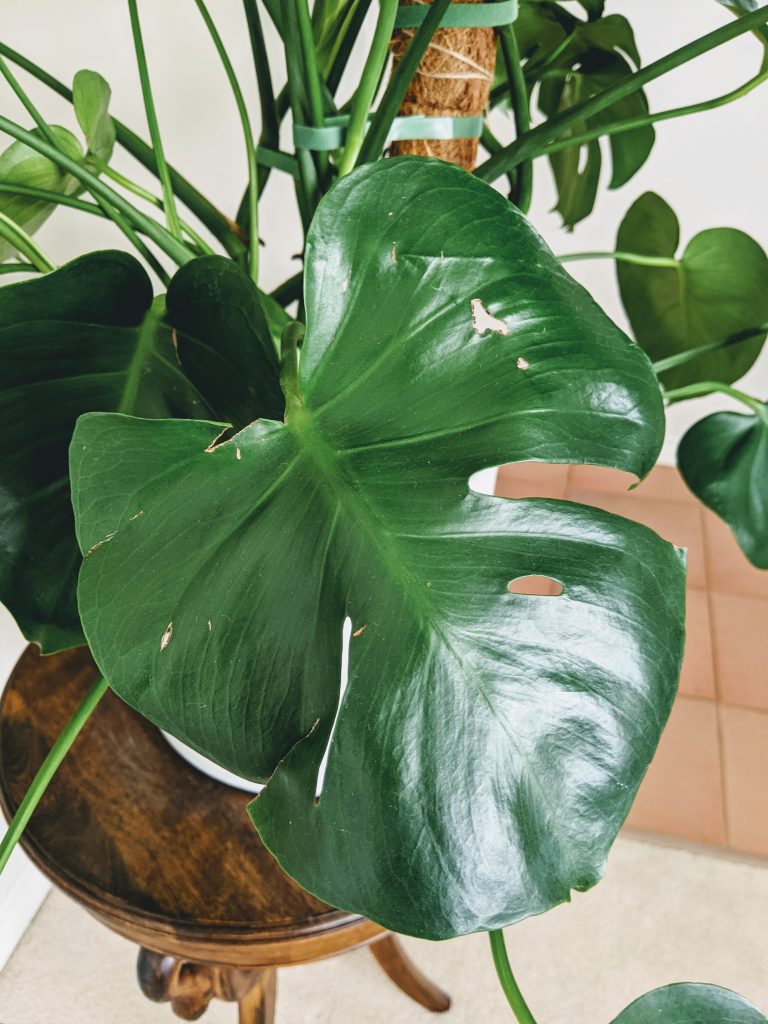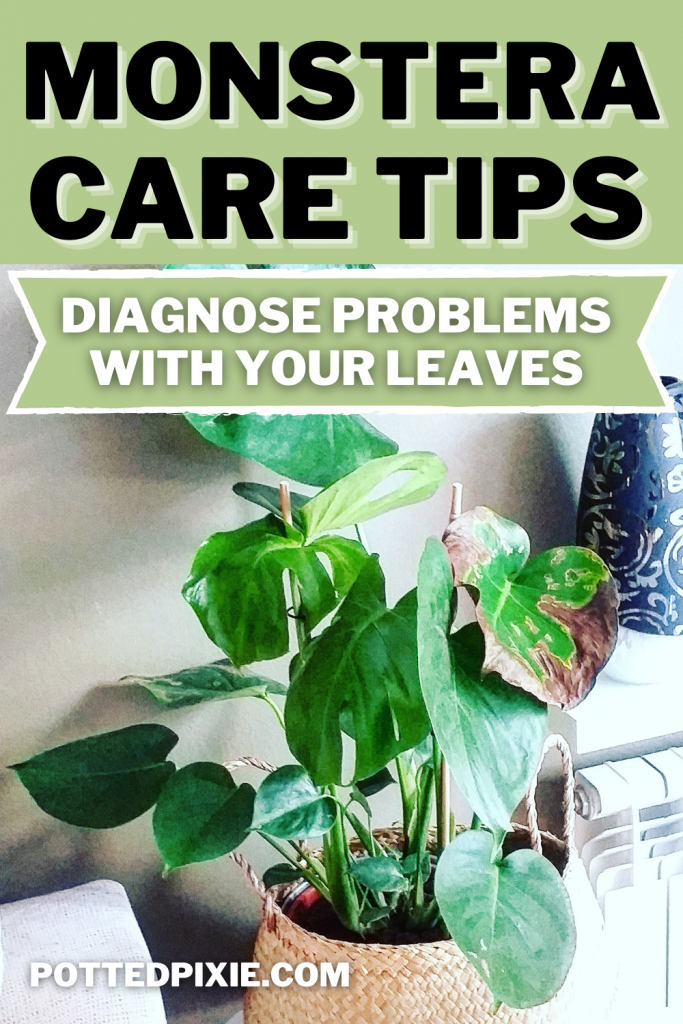Even though they are generally a hardy plant, damage to Monstera leaves can still occur quite easily. There are many different issues that can cause rips, tears, bending, curling and breakage. Some of these problems aren’t always a cause for concern, but others should be taken care of right away.
Here’s a list of potential reasons why your Monstera leaf might be damaged, what caused it and how to fix it (if it’s necessary).
Let’s take a look at the types of Monstera leaf damage and what to do about it.
This post contains affiliate links, which means I may make a small commission if you click through and make a purchase.
Monstera Leaves Ripping or Tearing is Usually Mechanical Damage

Monsteras are prone to mechanical damage which is physical damage to the leaf, usually caused by something bumping it, running into it, from being pinched while it was moved, or in my case (when a dog toy was actually thrown into it).
If your plant isn’t getting quite enough humidity, its leaves will be a little more delicate and more susceptible to not being handled very gently.
Fortunately this type of damage is mostly aesthetic and won’t affect the overall health of your plant.
Mechanical damage usually looks like tears or rips in your Monstera leaf. It can occur in the middle of the foliage or around the edges, and the wounds will be brown and ‘healed’ over.
You can identify this type of damage easily if the wounds, holes or marks are similar looking and evenly spaced out.

Usually this will appear as a couple of lines or holes that are decently uniform in appearance.
Leaves can also develop cracks if the air is too dry, particularly if it’s near a drafty spot in your house or if a fan is blowing too closely.
Since Monstera leaves get so big, they’re often accidentally brushed up against or walked into.
These brown rips in the leaves might look like something is eating your Monstera. But if they’re in a symmetrical or square pattern, this is likely mechanical damage.
Keep it in area of you house where the leaves aren’t touching any walls and where it won’t get bumped.
What to Do With Ripped Leaves

As far as what to do with a Monstera leaf that is experiencing mechanical damage, it’s really up to you.
It won’t harm the plant by keeping it intact, as it will still be able to photosynthesize.
But if it starts to die off or looks unsightly, you can cut it off at the stem.
Ideally, if there is a node, you can make a clean cut below the node and try to propagate the damaged leaf.
You don’t have to worry about pruning a stem here and there, Monsteras are one of the easiest plants to propagate, and you will likely notice more growth after cutting a few stems off.
Before you cut off a damaged leaf, make sure there isn’t a new leaf starting on the same stem.
If so, wait until the leaf has unfurled before trimming.
These rips and tears won’t really heal up and go away, they will remain as scars on the leaves.
If a chunk of your leaf has ripped but is still hanging on, you can snip off the ripped part and the remaining part of the leaf will just scab over and be ok.
Read next: How to Propagate a Monstera in Water in 5 Easy Steps (+ tips for success)
Monstera Leaves Bending or Drooping

A sign of underwatering a thirsty Monstera is when the leaves and stems are drooping or bending downwards. It may also look wilty.
This is an easy fix though, as the plant should bounce back to looking more lively after a good watering.
My Monstera seems to like water consistently every 7-8 days. If the soil feels dry on your finger 1-2 inches down, then it’s time to water.
If your plant is continuing to sprout new stems and you’re seeing a lot of new growth and you know it’s getting enough water, bending stems could also be a sign that it needs more support.
An easy fix is to place a moss pole in the soil and guide the stems to start growing upwards instead of outwards.
Also, check the size of your pot. If it’s a young plant, make sure the pot isn’t too big.
These plants can handle tight quarters for some time before needing to be repotted.
Plus, too big of a pot usually leads to overwatering as the soil will hold more moisture than necessary.
And a young plant won’t like these conditions.
Plus, overwatering almost always leads to root rot, which is a breeding ground for fungus gnats (learn how to get rid of them).
Yellowing and Brown Spots on Monstera Leaves

Yellow edges on your leaves are usually an indication of overwatering. If you’ve got yellow spots hanging out in the middle of your leaves, it could be an indication of root rot or fungal growth.
If you have brown spots (circles) with yellow around the edges (like a yellow halo), this is almost always an indication of a fungal problem.
If this is the case, you should pull your plant out of its pot and inspect the roots.
If they’re damp and mushy, it’s root rot.
Rinse of the roots with distilled water and cut off any of the rotted parts.
Then repot in fresh new soil and make sure it’s in a pot with drainage holes.
Yellowing leaves could also mean that the soil has become deficient and it needs more nutrients.
Always use the highest quality potting soil you can afford, and mix in some drainage, including both perlite or something like coco coir.
To bring your leaves back to life, I recommend this soil mixture recipe for Monsteras:
- ½ potting soil
- ¼ coco coir
- ¼ perlite
- Handful of organic fertilizer, such as worm castings.
If more than half of the lead is yellow and lifeless, you want to remove it.
Take a sharp knife and cut it off as close to the base of the stem as possible. Make a smooth, clean cut and always cut on an angle.
If you have new leaves sprouting that are brown or black before they unfurl, it’s likely a fungus problem or a definite sign that the plant has been getting too much water for too long.
Brown Edges
Brown tips on your Monstera leaves usually means they’re either in too bright of a location (getting too much sun) or it’s not getting enough humidity and starting to dry out.
If you have a variegated Monstera like the Albo or Thai Constellation, you’ll have to be extra careful as the white leaves are much more sensitive to hot sun and dry air.
Yellowing, Faded or Dehydrated Leaves Could be a Sign of Pests
Thoroughly check each leaf and stems for signs of pests.
If you find fungus gnats, these tiny black flies will be buzzing around your plant. They’re not very strong fliers, so you’ll know it’s them when they fly in a weak, zigzag pattern.
Fungus gnats generally don’t cause significant damage to your plant or leaves (unless they are left to infest for a very long time).
However, you’ll still want to get rid of them as soon as you notice a problem.
There are several natural methods you can use to get rid of gnats.
Check underneath the leaves. Scale bugs and spider mites are common pests attracted to Monsteras.
Scale is identified by mooth, brown bumps and spider mites are very small bugs that are hard to see, but leave a very fine webbing that is easily spotted.
Finally, if you know you don’t have a pest problem, the leaves on your Monstera could be tearing or drooping because of the water you are using.
Most people use tap water, but sometimes this water is too harsh for the plant due to it being treated.
You could try switching to distilled or filtered water for a few months and see if that makes a difference.
It won’t make a difference after one or two waterings, so you’ll have to monitor it.
Broken Stems
If the stem of your Monstera has snapped, it’s best just to remove it completely.
Using a sharp knife, cut it off at angle as close to the base of the stem as you can.
The old, broken stem won’t be able to repair itself, so it’s better to allow the plant to redirect its energy to producing new growth.
Why the Leaves on Your Monstera are Small and How to Grow them Bigger
If the unfurling leaves on your Monstera are small, it’s likely due to too small of a pot, not enough light, not enough humidity, depleted soil nutrients or not enough climbing opportunity.
It can also be a combination of all of these things.
First, it’s a good sign that the plant is continuing to sprout new leaves.
As long as we have that, we have a chance to improve the growing conditions to produce those big, beautiful leaves we’re all so in love with.
The first thing I would do is determine whether it’s time to repot your Monstera.
If it’s been in its pot for more than a year, chances are it needs a little more breathing room.
But don’t go too crazy with the pot size. Find a pot that a few inches wider and deeper than what it currently sits in.
When you’re repotting, I recommend you change out the soil completely.
Plants will use up most of the nutrients that the soil contains in about a year (less or more depending on how much light it gets).
For Monsteras (and most aroid plants), the best type of soil to use is a mixture containing coco coir and perlite.
The perfect time to add a moss pole to your Monstera is when you’re repotting it.
This allows you to position the pole perfectly and securely in the soil without damaging the plant’s roots.
Monsteras are climbing plants, so they need room to stretch out as they grow, and the moss pole helps replicate what they would do in the wild.
When they don’t have an opportunity to spread their wings, they stay small and compact.
Now that it’s got a bigger pot, fresh soil and room to climb, make sure it’s in a spot in your house where it gets the perfect amount of sunlight.
This gal wants plenty of bright and indirect light, but will do well with a good dose of early morning sunshine or soft afternoon sun.
Once your Monstera can start to climb, it will be able to access more light and produce bigger, fuller leaves.
And lastly, Monsteras do like a dash of humidity here and there. If you can provide it with several hours of humidity a day, even better; hey originate from tropical climates afterall.
Throw a plant humidifier beside it for a few hours a day would be the optimal humidity level. You can also spritz it with a mister once a day at minimum.
Visit my Houseplant Toolbox for a list of all my favorite supplies & goodies!
Stay Green!
More Monstera Posts:
Why Your Monstera is Dripping Water (Guttation Explained)
How to Propagate a Monstera in Water in 5 Easy Steps (+ tips for success)
9 Monstera Adansonii Varieties and How to Identify the Differences
Monstera Albo Care Guide: Easily Explained Tips for Success


